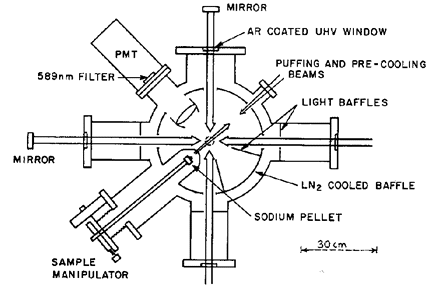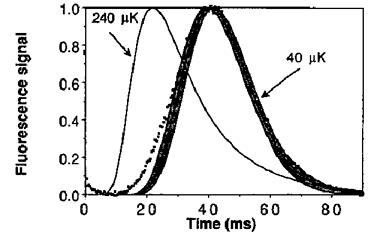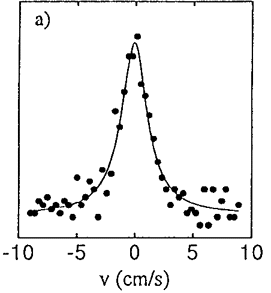Advanced information

Additional background material on the Nobel Prize in Physics 1997
15 October 1997
The Royal Swedish Academy of Sciences has decided to award the 1997 Nobel Prize in Physics jointly to
Professor Steven Chu, Stanford University, Stanford, California, USA,
Professor Claude Cohen-Tannoudji, Collège de France and École Normale Supérieure, Paris, France, and
Dr. William D. Phillips, National Institute of Standards and Technology, Gaithersburg, Maryland, USA,
for development of methods to cool and trap atoms with laser light.
This additional background material is written mainly for physicists.
The work of Steven Chu, Claude Cohen-Tannoudji and William D. Phillips in the field of laser cooling and trapping has meant a breakthrough for both theory and experiment within the field and has led to a deeper understanding of the interaction between light and matter. It has also led to an intense world-wide activity within the atomic, molecular and optical physics community and has, in particular, opened up new roads towards the study of the quantum behaviour of dilute atomic vapours at very low temperatures. The techniques of laser cooling and trapping are used in fundamental high resolution spectroscopy and the study of ultracold collisions. They also find application in the construction of atomic clocks, atomic interferometers and atom lasers, and in the development of instruments for atom optics and atomic lithography. Recent applications related to the 1997 Nobel Prize in Physics are the first observation of Bose-Einstein condensation in a dilute atomic gas and the development of the first rudimentary atom laser.
1. Historical background
Johannes Kepler, in an attempt to explain why the tails of comets entering our solar system always point away from the sun, suggested already in 1619 that light can have a mechanical effect. Important contributions to the theory of the so called “light pressure” were given by James Clerk Maxwell in 1873 and by Albert Einstein in 1917. Einstein showed, in particular, that absorption and emission of photons by atoms modifies the linear momentum of the atoms. The first process in which photon momentum played an important role was the Compton effect, i.e. the scattering of X-rays against electrons. The first observation of recoiling electrons was made in 1923 by C.T.R. Wilson in his cloud chamber. The first experimental observation of recoiling atoms was made by O.R. Frisch in 1933. With the invention of the tunable dye laser by P.P. Sorokin and F.P. Schäfer in 1966, an eminent tool for the further exploration of what has become known as “the mechanical properties of light” had been created.
Important early theoretical and experimental work on the action of photons on neutral atoms was made in the 1970’s by V.S. Letokhov and other physicists in the USSR and in the group of A. Ashkin at Bell Laboratories, Holmdel, NJ, in the USA. Among other things, they suggested bending and focusing atomic beams and trapping atoms in focused laser beams. This early work has, for example, led to the development of “optical tweezers” that can manipulate living cells and other small objects.
The first proposal to cool neutral atoms in counter-propagating laser beams was made by T.W. Hänsch and A.L. Schawlow in 1975. At the same time, a similar proposal was put forward by D.J. Wineland and H.G. Dehmelt, to be used for ions in ion traps. Hänsch and Schawlow proposed to cool neutral atoms in pairs of counter-propagating laser beams detuned slightly below a resonance transition of the atoms. Since the Doppler effect will tend to tune atoms moving towards one of the laser beams into resonance, these atoms will systematically be slowed down by the absorption of photons coming from the same direction and having energy below the resonance energy. Since the emission occurs in random directions it only leads to a small isotropic velocity distribution. Thus, the atoms moving towards the laser will lose velocity and effectively cool. Other atoms, with velocity components towards the other lasers, will cool in the same manner. In a gas of ideal two-level atoms one can easily calculate the limiting temperature, the so-called Doppler limit, which for the resonance transition in sodium would amount to 0.24 mK.
An important part in any attempt to cool and trap neutral atoms is to produce a beam of atoms slow enough to stay in the photon-atom interaction region for a sufficiently long time. Several attempts to slow down atomic beams by photons were made around 1980. A difficulty is that as the free atoms slow down, the frequency of the laser light has to follow the Doppler shifted resonance frequency, a technique proposed by Letokhov and called “frequency chirping”. W.D. Phillips and co-workers at the National Institute of Standards and Technology, NIST, Gaithersburg, USA, instead developed a scheme where the atomic beam propagates along the axis of a varying solenoidal magnetic field so that the Doppler and Zeeman shifts compensate and the resonance transition frequency is constant (“Zeeman slower”). Phillips used this technique in 1985 and was able to stop an atomic beam and to trap the atoms in a magnetic trap (of a kind proposed by D.E. Pritchard at MIT in 1983). Also in 1985, the full stopping of a neutral atomic beam by the frequency chirping method was demonstrated by J.L. Hall and co-workers at NIST in Boulder.
2. Optical molasses
In 1984, S. Chu and co-workers (among them Ashkin and J.E. Bjorkholm) at Bell Laboratories, Holmdel, NJ, set out to realize the Doppler cooling proposal of Hänsch and Schawlow. They used a beam of sodium atoms which first was slowed down by a frequency-chirped pre-cooling laser. After this laser had been turned off, the sodium atoms drifted into the intersection of six pairwise orthogonal counter-propagating laser beams (see Figure 1).
Figure 1. Schematic drawing of the vacuum chamber, intersecting laser beams and atomic beam used for the Doppler cooling experiment. The laser beams enter the UHV windows vertically and horisontally.
 |
In 1985, the group reported cooling a dilute vapour of about 105 neutral sodium atoms in a volume of 0.2 cm3 to a temperature of about 0.2 mK.
The motion of the atoms in the intersection region is similar to the movement in a hypothetical viscous medium, given the name “optical molasses” in the original publication (Phys. Rev. Lett. 55, 48 (1985)). Since the atoms are not trapped but fall slowly in the gravitational field, the cloud of cold atoms has a finite lifetime which in the original experiment was 0.1 s. This effect was actually used to estimate the temperature of the atoms in the intersection region by monitoring the decay of the fluorescence as the cooling lasers were turned off for a variable time interval. The result of this temperature measurement was consistent with the theoretical Doppler limit for sodium of 0.24 mK. Further developments of the optical molasses experiment eventually led to an increase in the density of atoms to 109 per cm3 and to observation times up to 1 s.
For the laser-cooled neutral atoms moving in optical molasses to become really useful one needed a trap. This trap had to be deeper than the magnetic trap used by Phillips in 1985 or the focused laser beam trap proposed by Letokhov and Ashkin and realized in 1986 by Chu and co-workers in optical molasses experiments. In 1987 Pritchard and Chu, following a suggestion by J. Dalibard, developed the workhorse of later experiments, the magneto-optical trap (MOT). This also uses the three pairs of counter-propagating laser beams, but now with circular polarization and in conjunction with a weak magnetic field.
Following suggestions by J.R. Zacharias and Hänsch, Chu also developed an atomic fountain for high precision spectroscopy. Cooled and trapped atoms are there launched upwards in the gravitational field, in trajectories with turning points inside a microwave cavity, in which the slow atoms are resonantly excited by a succession of two microwave pulses. The technique of using two excitation regions for atomic beams was pioneered by N.F. Ramsey and is used in the most precise atomic clocks. Today these clocks have a precision of 10-14, while a new design based on atomic fountains is predicted to improve the precision by a factor 100.
3. Sub-Doppler cooling
Meanwhile, W.D. Phillips and his group at NIST studied a cold cloud of neutral sodium atoms slowly moving in optical molasses. Prompted by small disagreements between theory and experiment, which were also noted by Chu, they developed methods to measure the temperature of the cloud under varying cooling conditions in a more precise manner. In particular, they adopted a technique to determine the time-of-flight of falling atoms to reach a set of probe laser beams below the optical molasses region. In early 1988, they discovered that the atoms had a temperature of about 40 µK, much below the predicted Doppler limit of 240 µK (Phys. Rev. Lett. 61, 169 (1988)). They also found that the lowest temperatures were reached under conditions that contradicted those of the theoretical Doppler limit.
Figure 2. Time-of-flight data compared to calculations for assemblies of sodium atoms at two different temperatures. The shaded area indicates the range of error in the calculation. Evidently, the cloud has reached a temperature of 40 µK, which is six times below the Doppler limit.

Experiments by the groups of Chu, who now had moved to Stanford University, and of C. Cohen-Tannoudji at École Normale Supérieure in Paris, soon confirmed that the discovery of Phillips was real. The explanation of the discrepancy came almost immediately from J. Dalibard and Cohen-Tannoudji in Paris and from the Stanford group. The theory of Doppler cooling and the Doppler limit assumes an atom with a simple two-level energy spectrum. Real sodium atoms, on the other hand, have several Zeeman sublevels, both in the ground state and in the excited state. The ground state sublevels can become optically pumped, i.e. laser light can transfer sodium atoms into different distributions of sublevel populations and give rise to new cooling mechanisms. Details of the population distributions depend on the laser polarization, which is changing rapidly over a distance of one optical wavelength within the molasses. For this reason the new cooling mechanisms go under the general name of polarization gradient cooling. The particular mechanism originally discovered by Phillips has been given the name Sisyphus cooling, in analogy to the character in Greek mythology, who was condemned to push a heavy stone uphill only to find after having reached the crest that the stone rolled down and he had to start all over again. The atoms are always losing kinetic energy as if moving uphill, being optically pumped back to a valley by the laser field, and start uphill again.
During a visit to Paris in 1989, Phillips collaborated with the group at École Normale Supérieure. They showed that neutral cesium atoms could be cooled to 2.5 µK. As for Doppler cooling, there seems to exist a fundamental lower limit also for other kinds of laser cooling. This so called recoil limit would correspond to the temperature of a cloud of atoms moving with velocities of the order of the velocity of the recoil from a single photon. For sodium atoms the recoil temperature is 2.4 µK while for cesium atoms it is as low as 0.2 µK. The experimental results quoted above thus seemed to indicate that it is possible to reach a temperature of about ten times the recoil limit using polarization gradient cooling of a disordered cloud of atoms. In a recent development one has been able to trap the cooled atoms in the sites of what is called an optical lattice. Such a lattice has a spacing of the order of an optical wavelength and it can be adjusted by changing the laser beam configuration. Since the atoms are more effectively cooled at the lattice sites than at arbitrary positions, a temperature about half of what can be reached in the disordered state can be achieved. For example, 1.1 µK has been reached for cesium.
4. Sub-recoil cooling
The reason that the recoil energy of a single photon sets a limit to both Doppler cooling and polarization gradient cooling is that in both cooling schemes there is a continuous cycle of absorption and emission processes taking place. Each process gives the atom a small but non-negligible recoil energy. If atoms almost at rest could be exempted from the absorption-emission cycle, one might in principle reach sub-recoil limit temperatures in dilute atomic vapours. Already in the 1970’s a mechanism in which atoms in an intense laser field can be optically pumped into a non-absorbing coherent superposition of states, a so called dark state, was discovered at the University of Pisa. C. Cohen-Tannoudji, together with several co-workers at the École Normale Supérieure in Paris, among them E. Arimondo (from Pisa) and A. Aspect, has shown in a series of experiments how the Doppler effect can be used to ensure that only the coldest atoms end up in the dark state. This so called velocity selective coherent population trapping (VSCPT) method was first applied in 1988 in one dimension (Phys. Rev. Lett. 61, 826 (1988)), in 1994 in two dimensions (Phys. Rev. Lett. 73, 1915 (1994)) and in 1995 in three dimensions (Phys. Rev. Lett. 75, 4194 (1995)).
All three experiments used metastably excited helium atoms He(1s2s3S) for which the Doppler limit is 23 µK while the recoil limit is 4 µK. Already in 1988, Cohen-Tannoudji and co-workers used two counter-propagating laser beams and could show cooling in one dimension to a temperature of 2 µK, a factor of two below the recoil limit. The experiment was developed to two dimensional cooling in the beginning of the 1990’s. In 1994, together with Aspect and an otherwise new set of co-workers and using two pairs of mutually orthogonal and counter-propagating laser beams, Cohen-Tannoudji could show cooling in two dimensions to 250 nK, about 16 times below the recoil limit temperature. Finally, in 1995, the experiment was developed to include three sets of laser beams and cooling in three dimensions was shown. The minimum temperature now became 180 nK, 22 times below the recoil limit (see Figure 3). Even though other groups have participated in the developments of sub-recoil cooling, notably Chu and collaborators, it is the work of Cohen-Tannoudji which has opened the new area of sub-recoil laser cooling.
Figure 3. Profile of the atomic velocity distribution in three-dimensional sub-recoil cooling. The single photon recoil velocity is 9.2 cm/s while the spread of the cooled atoms is about 2 cm/s.
 |
5. Applications
There has been a tremendous progress in the field of laser cooling and trapping of neutral atoms over the last decade. The three Nobel Laureates and their collaborators have, together with many other scientists, laid the groundwork for exciting developments within a number of subfields of physics. The development of methods to cool dilute vapours of trapped atoms to temperatures hitherto only reached in isolated parts of condensed matter systems, has made it possible to construct atomic clocks useful for precise timekeeping, e.g., in connection with navigation in space and the exploration of the solar system. Another application using laser cooling is the development of atomic interferometers in which the de Broglie wavelength of slow atoms is used for interferometric measurements with ultrahigh precision, e.g., of the acceleration of gravity. Refined instruments for atom optics have also opened the road towards atomic lithography. The atomic beams may be used to form nanometer structures on surfaces, e.g., for electronic components. The recent observation of a Bose-Einstein condensation in a dilute atomic gas is also related to the groundbreaking work on laser cooling and trapping described in this short background material.
| Further reading |
| “Cooling and Trapping Atoms”, by William D. Phillips and Harold J. Metcalf, Scientific American, March 1987, p.36. |
| “New Mechanisms for Laser Cooling”, by Claude N. Cohen-Tannoudji and William D. Phillips, Physics Today, October 1990, p. 33. |
| “Laser Trapping of Neutral Particles”, by Steven Chu, Scientific American, February 1992, p. 71. |
| “Le Refroidissement des Atomes par Laser”, by A. Aspect and J. Dalibard, La Recherche, January 1994, p. 30. |
| “Experimenters Cool Helium below Single-Photon Recoil Limit in Three Dimensions”, by Gloria B. Lubkin, Physics Today, January 1996, p. 22. |
Nobel Prizes and laureates
Six prizes were awarded for achievements that have conferred the greatest benefit to humankind. The 12 laureates' work and discoveries range from proteins' structures and machine learning to fighting for a world free of nuclear weapons.
See them all presented here.
